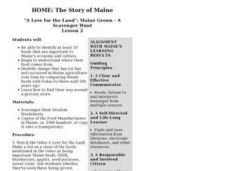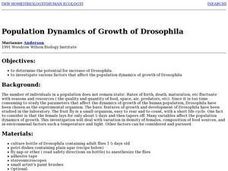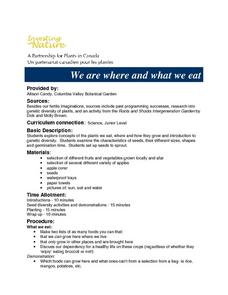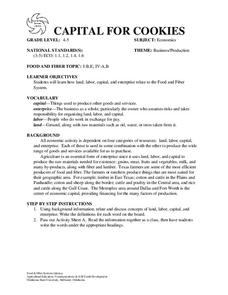Curated OER
CALORIE COUNTDOWN
Pupils will categorize foods according to their components and energy content.1. Design a large bulletin board with sections for carbohydrates, fats and proteins.
2. Ask students to bring labels and packages of different food products....
Curated OER
Sun Prints
Young scholars use coins to help them explore the sun as a source of renewable energy. They go outside in the sunshine and make a design by placing coins on their piece of black construction paper.
Curated OER
The Secreat to Good Health: Eating Right and Exercise
Students create a seven-day record of all the foods they consume. They analyze what type of food was the most frequent in everyone's diet. They look up each food and record its daily recommended amount.
Curated OER
Where Do We Get the Money We Spend?
Students discuss the sources of income for people in their community. They examine why different jobs are paid different wages. They also classify productive resources in the economy.
Curated OER
Healthy School Challenge Activity
In this healthy diet worksheet, students complete a chart, filling in school name and month served, then completing food and portion sizes served at school each day for given categories.
Curated OER
Home: The Story of Maine
Students identify at least 10 foods that are important to Maine's economy and culture. They participate in a scavenger hunt as they find their way around a grocery store.
Curated OER
Population Dynamics of Growth of Drosophila
Students experiment with Drosophila to determine if density of female flies, food sources, temperature and light affect the population dynamics of growth. Students graph their data and compare their results to the number of human...
Curated OER
Population Dynamics of Growth of Drosophila
Students investigate population dynamics such as variation in density of females, composition of food sources an environmental factors such as light and temperature on Drosophila. They then relate their findings to human populations and...
Curated OER
We are where and what we eat
Students explore concepts of plants they eat, where and how they grow and are introduced to genetic diversity. They examine seed characteristics, look at their different sizes, shapes and germination time. They also set up seeds to...
Curated OER
Who Can Harvest A Walleye?
Seventh graders investigate the concept of how an ecosystem is put together while conducting research using a variety of resources. They correctly differentiate between a herbivore and carnivore by placing them in the order of hierarchy...
Curated OER
Don't Water....Shed A Tear#145
Students examine the definition and attributes of tributaries and watersheds. They design a landscape which includes a mountain, a river, a lake and other appropriate items. They observe as the teacher pours water through the landscape...
Curated OER
Foreign Language Dictionary Unit
Eighth graders create a Spanish or French language dictionary using online resources. They decide on a theme for their dictionary. They complete the template sheet by adding a word for each letter of the alphabet and inserting graphics...
Curated OER
Capital for Cookies
Students explore how land, labor, capital, and enterprise relate to the Food and Fiber System. They write a story about a company they would open in the community, create a company to make an agricultural product and discuss the various...
Curated OER
Health and Nutrition
Fifth graders explore nutrition and health ideas to maintain their energy. In this energy lesson, 5th graders read information about ways to keep their energy boosted. Students keep a diary of what they each and create a chart for the...
Curated OER
NECESSARY WRAPPERS?
Students bring in a packaged item to unwrap. They weigh the pile of packaging and pile of product and determine which weighs more. They identify the source of raw materials for packaging and discuss ways to reduce packaging and overall...
Curated OER
Everyday vs. Extreme Relationships with Nature
Students examine the interactions with nature and the environment. They discover where water comes from and ways to conserve water. They also examine energy sources and consumption.
Curated OER
Underground Pollution
Fourth graders construct their own aquifer. They discover how water travels underwater and identifies sources of underground pollution. They record their observations and discuss the results.
Curated OER
Build A Model of the Water Cycle
Students identify and describe the steps in the water cycle. They discover the sun as the source of the cycle. They work together to create their own water cycle model.
Curated OER
In Your Own Backyard
Young scholars observe organisms in their habitat and record their observations. They then draw conclusions about the organism's habitat needs and food sources.
Curated OER
What does AG have to do with me?
Students practice alphabetizing while categorizing sources of basic agricultural products. They discuss agricultrual products, discover where they are grown and draw a simple agricultural scene on poster board.
Curated OER
Don't Marry the Mole!
Third graders examine the power of solar energy. In groups, they create their own pizza box solar oven to discover the power of the sun and how it is a source for heat and light. To end the lesson, they use the internet to examine...
Curated OER
Rosa Parks Community Garden
Ninth graders investigate how we depend on plants as the original source of most food. They investigate the parts of plants, and which parts are edible. Students are explained that the garden is also a classroom and the same rules apply.
Curated OER
Precious Water: Is it a Need, a Right, or a Commodity?
Students determine whether water is a need, a right, or a commodity. For this water lesson, students investigate land and water ecosystems through activities. Students also discover water as a resource and energy source as they observe...
Curated OER
Carbohydrates, Proteins, and Fats
Young scholars describe the properties of carbohydrates, proteins and fats. In this health science lesson, students identify food sources where these nutrients can be found. They explain how they affect our body.
Other popular searches
- Food Sources
- Food Origins
- Aboriginal Food Sources
- Esl Food Sources
- Food Origins Of
- Science Sources of Food

























